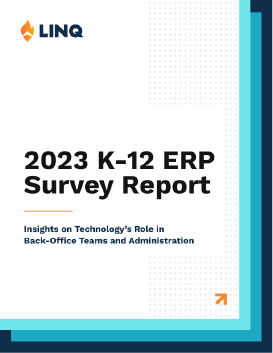Automation is a game-changer across industries, keeping processes moving and creating unprecedented efficiency. From assembly lines to customer service, automation reshapes the landscape of work, freeing employees and leaders to focus on innovation, personalized service, and creativity. Education is no different—schools and districts implementing technology to automate their processes gain the ability to shift everyone’s focus to people instead of paperwork.
By automating repetitive and time-consuming tasks, K‑12 schools can streamline operations, reduce administrative burden, and allow staff members to direct their energy toward strategic and meaningful initiatives. It’s a winning formula for taking head-on today’s toughest challenges in education, like teacher and staff shortages, tight budgets, and student learning support.
“A stitch in time saves nine.” How modernizing K‑12 technology makes the proverb ring true.
Benjamin Franklin’s famous proverb rings truer today than it did in 1732. Automating processes can transform the workday of K‑12 back-office teams overwhelmed with manual administrative tasks. Data entry, record-keeping, and report generation need to get done, but technology is getting good at handling the heavy lifting. Automation frees back-office staff from these time-consuming tasks so they can devote more attention to critical responsibilities.
Schools and districts need the human expertise of administrators, finance professionals, HR experts, and all back-office staff to meet challenges with innovative solutions and personal attention. Strategic planning, data analysis, and student support are critical to school and district success. Employees recognize that automation enables them to prioritize important aspects of their job like these, with 81% of people agreeing that it can create more time to focus on valuable tasks. And time can equal money when staff members turn their energy toward finding ways to cut costs and use districts resources more economically.
Time savings add up when K‑12 districts modernize back-office systems
In our latest ERP research survey, 14% of K‑12 professionals report that none of their back-office systems support automation. Something as simple as requesting time off requires two in 10 staff members to phone in manually, email, or inform their school in person. Although the time it takes to complete mundane tasks can seem small, it adds up.
Additional research shows:
- Work about work remains a persistent issue, with just over half of the 40-hour workweek lost to menial, repetitive tasks.1
- Over one year, 257 hours could be saved with improved processes.2
- Teams spend 13% of their time on work already completed—236 hours per year, or up to 30 days.3
- 69% of workers waste up to an hour a day navigating between apps, up to 32 days per year.4
Those numbers seem almost too big to be believable but absent automation, it’s easy to see how they add up.
Here’s how automating K‑12 back-office processes could save you countless hours
Let’s take a simple example: a field trip permission slip for 4th graders. Twice a year, 4th graders take a field trip to a local science museum.
You have six elementary schools, so that’s 12 field trips. But there are four 4th-grade classrooms per campus (48), and every classroom has 27 students.
That’s 1,296 permission slips that need to be completed per year.
If every form takes three minutes to transcribe, that’s almost three days on permission slips for one grade.
That’s assuming the information received is correct. Let’s say that 10% of the permission slips (129) aren’t completed on time, and you must provide the information to the museum by a specific date. So, it’s an additional 10 minutes per missing permission slip—1,296 minutes or almost a day.
Automation beyond forms offers districts another opportunity. Fixed inventory asset management is entirely manual for 36% of K‑12 business professionals surveyed for our study. Two in 10 respondents report manually handling purchase orders.
Improved accuracy means better data
Manual data entry can be a significant expense for K‑12 districts of any size. It can result in the cost of time lost, potential regulatory fines, and employee turnover—all because of errors.
When it comes to manual data entry, a general rule of thumb is that human error rates usually hover around 1%. Some studies suggest an error rate of almost 4%, with over 14% of errors containing significant and potentially dangerous discrepancies. Even the best employees in your back office are only human and prone to occasional mistakes due to exhaustion, boredom, multi-tasking, stress, and simply misreading information.
Automation minimizes chances for errors, ensuring greater accuracy and data integrity. For example, automated systems can populate student information directly from registration forms, reducing the need for manual data entry and eliminating transcription mistakes. By relying on automated processes, K‑12 schools can maintain accurate and up-to-date records, leading to more informed decision-making and reliable data insights.
Modernizing K‑12 administrative technology to improve cybersecurity
A recent K‑12 Dive survey5 found that among lower education institutions, 47% reported an increase in the volume of cyberattacks. According to a 2022 Microsoft Security Intelligence report,6 K‑12 school districts are among the hardest hit by malware and cyber-attacks.
A growing number of data breaches across educational institutions can prove costly and put a considerable amount of sensitive and confidential information at risk. K‑12 schools handle sensitive student and staff data that must be protected and kept confidential. Automation can strengthen data security by implementing access controls, encryption, and audit trails. Automated systems can also help schools comply with data privacy regulations like the Family Educational Rights and Privacy Act (FERPA) or the General Data Protection Regulation (GDPR). By automating data management and security processes, back-office staff can ensure the integrity and privacy of sensitive information.
Automation is a transformative force that brings immense benefits to the back-office staff in K‑12 schools. By leveraging automation technology, educational institutions can optimize their operations, reduce administrative burdens, improve data accuracy, and strengthen data security. Embracing automation empowers back-office staff to focus on value-added tasks, ultimately benefiting students, parents, and the entire educational community.
See the latest trends and priorities in K‑12 operations software modernization
Our latest research report contains survey results and expert insights about the future of K‑12 technology. Find out how districts plan to modernize and automate systems and processes in 2023 and beyond.

1 https://resources.asana.com/rs/784-XZD-582/images/PDF-FY23-GLOBAL-EN-AOW23-GLOBAL-Anatomy-of-Work-Report.pdf
2 Ibid
3 https://kanboapp.com/what-you-need-to-know-about-work-about-work/
4 Ibid
5 https://www.k12dive.com/news/56-percent-k-12-schools-worldwide-report-ransomware-attacks-in-past-year-cybersecurity/627321/
6 https://www.microsoft.com/en-us/wdsi/threats
